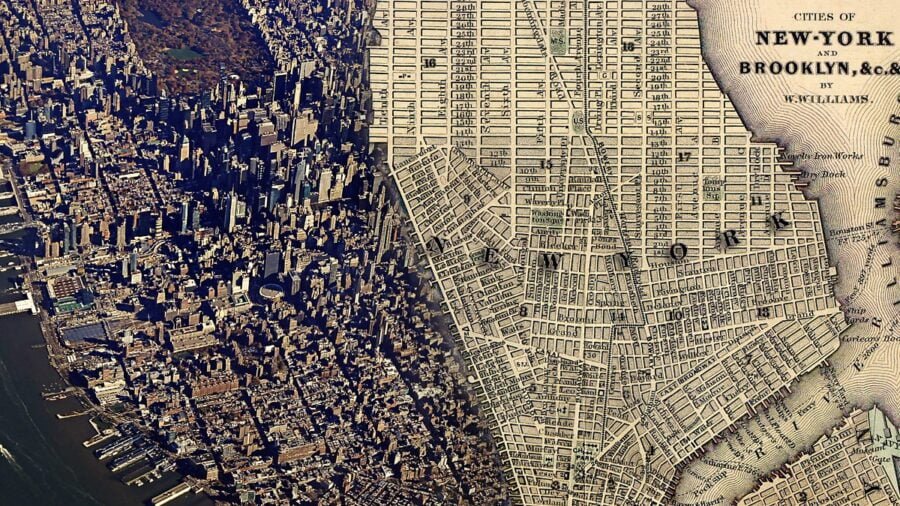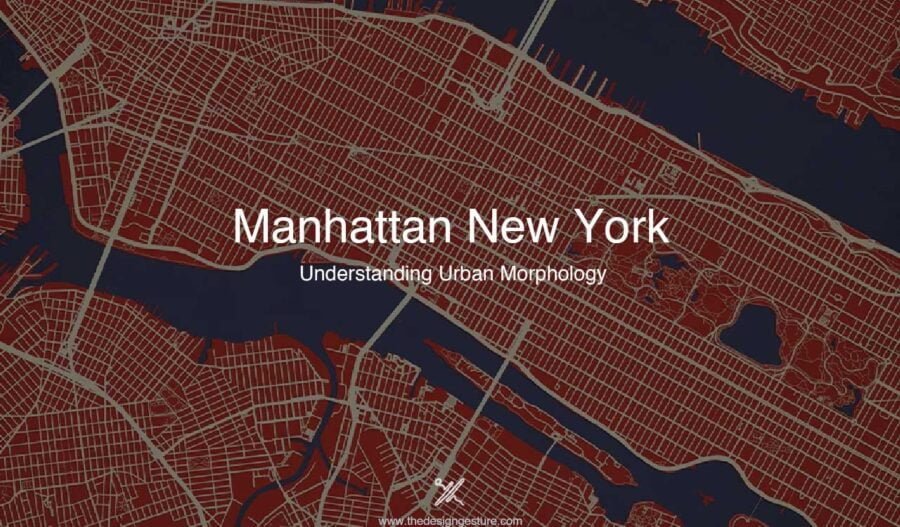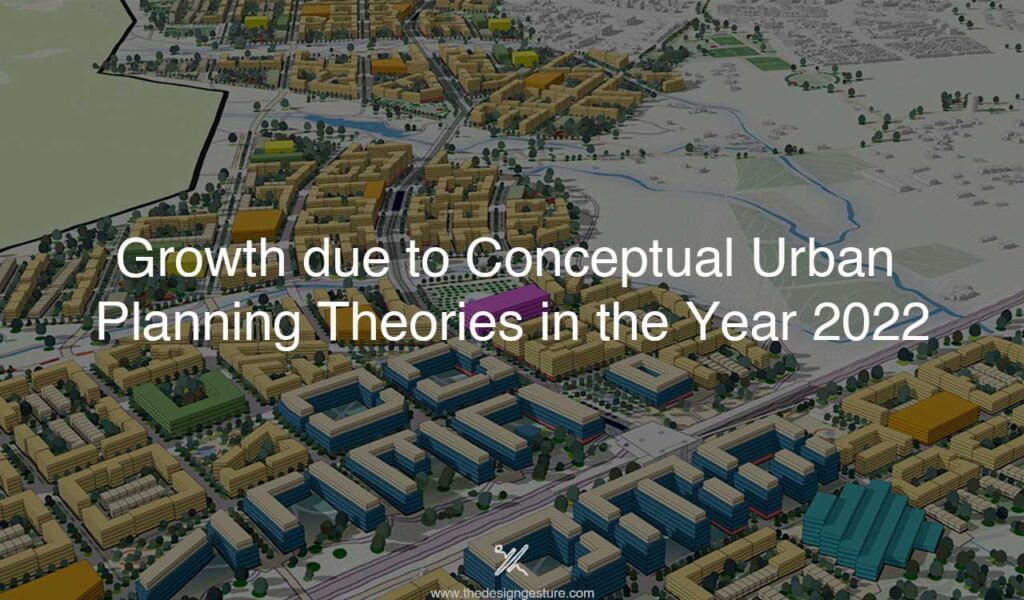Urban morphology is the study of urban spaces that are physically laid up and constructed, with an emphasis on how these spaces have changed over time. It entails examining building type, public areas, land use patterns, roadway patterns, and plot patterns. By solidly understanding urban morphology, urban planners, architects, and geographers can better comprehend how cities change over time and how their structures affect social, economic, and environmental processes. Urban shapes, street patterns, plot patterns, building typology, public areas, and patterns of land use are important ideas. In this article, we will be understanding the urban morphology of Manhattan.
Table of Contents
Urban Morphology Foundation
Urban morphology emerged as a scholarly discipline in the early 1900s, establishing itself within the broad domain of human geography. Urban landscapes were built by intricate patterns and systems that early practitioners of this emerging profession attempted to comprehend, much like an archaeologist sifting through layers of history to piece together the present. The popularity of urban morphology changed throughout time, peaking primarily in American and British academics in the 1950s and 1960s. When urban morphology was at its peak, it was hailed as a beacon of hope that unveiled previously undiscovered facets of the character of cities. Because of how closely it explored the historical and physical aspects of these places, it was dubbed the “DNA” of cities.

However, as the academic environment changed, other movements that impacted the study of urban morphology included the “quantitative revolution” and the “cultural turn.” A wave of mathematical and statistical approaches to geography was brought about by the “quantitative revolution,” momentarily drawing attention away from the qualitative features of urban form. In the meantime, the “cultural turn” frequently neglected the study of physical form in favor of focusing on the cultural and sociological aspects of cities. The popularity of urban morphology fluctuated as a result of these academic headwinds.
Urban morphology, however, endured despite the shifting tides, proving its adaptability and durability. It survived the storms of ideas and continued to be important in the field of urban geography. As cities developed and expanded, urban morphology became a leading aspect of understanding the physicality of urban areas based on the dynamics and nature.
Understanding Urban Morphology
As it deals with the urban environment, it requires a comprehensive study of the urban environment regarding landforms, built typology, and expansion. The following aspects unveil a better understanding of the morphology and city.
Classification of the Urban Space
Classification is based on the physicality of the urban space; a method that categorizes cities based on the physical features being a street pattern, plot size, and architectural manifestation.
History and Historical Process
Examination and understanding of the city with time. Urban morphology is a historical detective, investigating the processes that shaped cities into their current forms. Historical documents, maps, and archives must be thoroughly examined to monitor cities’ growth over time. Urban morphologists can better understand the forces, events, and decisions that have shaped the urban landscape by connecting these historical threads.
Formation Understanding
The study of urban morphology goes beyond simple observation and categorization to understand the forces that shape urban environments. This includes investigating the aims, motivations, and actions of those who have shaped cities, ranging from planners and architects to everyday citizens. Urban morphologists get insights into the human narratives that are woven into the cityscape by identifying the driving forces behind it.
Manhattan, New York
Developed in the Commissioners’ Plan of 1811, Manhattan is well known for its gridiron street layout. With avenues running north-south and numbered streets running east-west, this layout split Manhattan into a grid of streets and avenues. This design makes navigating about the borough simple and has grown to be recognized as a municipal hallmark. Skyscrapers dominate Manhattan’s skyline, particularly in the financial sector in Lower Manhattan and Midtown Manhattan’s major business sector. A canyon-like impression is produced along prominent avenues like Park Avenue, Broadway, and Fifth Avenue due to the concentration of towering buildings.
The close coexistence of commercial, residential, cultural, and recreational activity indicates Manhattan’s mixed land use. While Greenwich Village and the Upper East Side include a mix of residential and business structures, Midtown Manhattan is renowned for its dense concentration of office buildings, hotels, and retail outlets.
Additionally, with a high concentration of people living and working inside its comparatively small geographical area, Manhattan is one of the most densely inhabited urban districts in the United States. Due to the island’s limited acreage, the city has grown vertically and large structures have been built.
The vast green area known as Central Park is situated in the center of Manhattan. Central Park, created by Frederick Law Olmsted and Calvert Vaux, offers a getaway from the bustle of the city by presenting green spaces, walking routes, and recreational amenities. The Hudson River to the west and the East River to the east encircle Manhattan. Over time, the waterfront sections have experienced extensive rehabilitation, turning abandoned industrial sites into thriving mixed-use neighborhoods with parks, promenades, and residential buildings.
Manhattan has an extensive transportation network, which includes subway lines, buses, ferries, and bridges that connect it to the surrounding boroughs and beyond. The island’s transportation infrastructure is critical to allowing the flow of people and products across the metropolis. Manhattan’s urban morphology is defined by its unique gridiron pattern, skyscraper skyline, diverse land use, urban density, famous landmarks, and dynamic evolution over time. These qualities contribute to Manhattan’s reputation as a thriving and dynamic urban metropolis of worldwide significance.

Challenges and Complexities in Urban Morphology
Urban morphology confronts several issues and controversies that require attention. In comparison to other geographical disciplines, this one lacks a firm theoretical base. The incorporation of more theoretical foundations is critical for urban morphology to remain relevant. Another challenge is using modern depictions of urban settings to recreate historical forms. It is a hard endeavor with restrictions, and multidisciplinary collaboration with archaeologists is becoming increasingly important. Furthermore, bridging the gap between urban morphology theory and actual urban planning and design can be difficult. Overcoming this separation and promoting meaningful collaboration between geographers and architects is critical.
The evolution of urban morphology is ongoing. The demand for a stronger theoretical base is rising. Getting involved with modern geography theory will advance the field. Additionally, encouraging collaboration between academia and industry will guarantee that the body of knowledge on urban morphology has an impact on significant urban growth.




